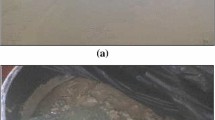Abstract
One of the problems to affect Portland cement matrices is low resistance to aggressive agents, due principally to the presence of a high content of portlandite in the hydrated cements. Pozzolanic materials have, for decades, played an important role in improving the durability of cement-based materials. This work studies the behaviour of cement mortar matrices blended with 10% calcined paper sludge (source for metakaolin, MK) and exposed to different environmental conditions (marine and tableland environments). The results obtained using X-ray diffraction and scanning electron microscopy/energy-dispersive X-ray analyser techniques show that the ions present speed of different penetration as well as various phases and/compounds in the matrices following exposure over 1 year.










Similar content being viewed by others
References
Anstice, D. J., Page, C. L., & Page, M. M. (2005). The pore solution phase of carbonated cement pastes. Cement and Concrete Research, 35(3), 377–383. doi:10.1016/j.cemconres.2004.06.041.
Boddy, A., Hooton, R. D., & Gruber, K. A. (2001). Long-term testing of the chloride penetration resistance of concrete containing high reactivity metakaolin. Cement and Concrete Research, 31(5), 759–765. doi:10.1016/S0008-8846(01)00492-6.
Caré, S. (2008). Effect of temperature on porosity and on chloride diffusion in cement pastes. Construction and Building Materials, 22, 1560–1573. doi:10.1016/j. conbuildmat. 2007.03.018.
Coleman, N. J., & Page, C. L. (1997). Aspect of the pore solution chemistry of hydrated cement pastes containing metakaolin. Cement and Concrete Research, 27(1), 147–154. doi:10.1016/S0008-8846(96)00184-6.
Costa, A., & Appleton, J. (1999). Chloride penetration into concrete in marine environment—Part II: Prediction of long term chloride penetration. Materials and Structures, 32, 354–359. doi:10.1007/BF02479627.
Fidalgo Hijano, C., Petit Domínguez, M. D., García Giménez, R., Hungría Sánchez, P., & Sancho García, I. (2005). Higher plants as bioindicator of sulphur dioxide emissions in urban environments. Environmental Monitoring and Assessment, 111(1–3), 75–88. doi:10.1007/s10661-005-8140-6.
Frías, M., Sánchez de Rojas, M. I., Rodríguez, O., García, R., & Vigil, R. (2008a). Characterization of calcined paper sludge as an environmental friendly source of metakaolin for manufacture of cementitious materials. Advances in Cement Research, 20(1), 23–30. doi:10.1680/adcr.2008.20.1.23.
Frías, M., Rodríguez, O., Vegas, I., & Vigil, R. (2008b). Properties of calcined clay wastes and its influence on blended cement behaviour. Journal of the American Ceramic Society, 91(4), 126–1230. doi:10.1111/j.1551-2916.2008.02289.x.
García, R., Vigil de la Villa, R., Vegas, I., Frías, M., & Sánchez de Rojas, M. I. (2008). Pozzolanic properties of paper sludge waste. Construction & Building Materials, 22(7), 1484–1490. doi:10.1016/j.conbuildmat.2007.03.033.
Glass, G. K., Hassanein, N. M., & Buenfeld, N. R. (1997). Neural network modeling of chloride binding. Magazine of Concrete Research, 49(181), 323–335.
Govindaraju, K. (1994). Compilation of working values and sample description for 383 geostandards. Geostandards Newsletter.
Han, S. H. (2007). Influence of diffusion coefficient on chloride ion penetration of concrete structure. Construction & Building Materials, 21, 370–378. doi:10.1016/j.conbuildmat.2005.08.011.
Kakali, G., Kasselouri, V., & Parissakis, G. (1990). Investigation of the effect of Mo, Nb, W and Zr oxides on the formation of Portland cement clinker. Cement and Concrete Research, 20(1), 131–138. doi:10.1016/0008-8846(90)90123-F.
Mc Polin, D., Basheer, P. A. M., Long, A. E., Grattan, K. T. V., & Sun, T. (2005). Obtaining progressive chloride profiles in cementitious materials. Construction & Building Materials, 19, 666–673. doi:10.1016/j.conbuildmat.2005.02.015.
Mejía Gutierrez, R., & Talero, R. (2001). Una nueva puzolana para materiales cementicios de elevadas prestaciones. Materiales de Construcción, 50(260), 21–29.
Penttala, V. (2006). Surface and internal deterioration of concrete due to saline and non-saline freeze-thaw loads. Cement and Concrete Research, 36, 921–928. doi:10.1016/j.cemconres.2005.10.007.
Polder, R. (2002). Characterization of chloride transport and reinforcement corrosion in concrete under cyclic wetting and drying by electrical resistivity. Cement and Concrete Composites, 24, 427–435. doi:10.1016/S0958-9465(01)00074-9.
Pressi, M., Geyskens, P., & Monteiro, P. J. M. (1996). Reliability approach to service life prediction of concrete exposed to marine environment. ACI Materials Journal, 93(6), 554–562.
Roy, D. M., Jiang, W., & Silsbee, M. R. (2000). Chloride diffusion in ordinary, blended and alkali-activated cement pastes and its relation to other properties. Cement and Concrete Research, 30, 1879–1884. doi:10.1016/S0008-8846(00)00406-3.
Schueremans, L., Van Gemert, D., & Giessler, S. (2007). Chloride penetration in RC-structures in marine environment. Long term assessment of a preventive hydrophobic treatment. Construction & Building Materials, 21, 1238–1249. doi:10.1016/j.conbuildmat.2006.05.006.
Schultz, L. G. (1964). Quantitative interpretation of the mineralogical composition from X-ray and chemical data for the Pierre Shale. US Geological Survey Professional Paper, 391C.
Shah, M. N., Shaheen, N., Jaffar, M., Khalique, A., Tariq, S. R., & Manzoor, S. (2006). Spatial variations in selected metal contents and particle size distribution in an urban and rural atmosphere of Islamabad, Pakistan. Journal of Environmental Management, 78, 128–137. doi:10.1016/j.jenvman.2005.04.011.
Temiz, H., & Karakeci, A. Y. (2002). An investigation on microstructure of cement paste containing fly ash and silica fume. Cement and Concrete Research, 32(7), 1131–1132. doi:10.1016/S0008-8846(02)00749-4.
Vigil de la Villa, R., Frías, M., Sánchez de Rojas, M. I., Vegas, I., & García, R. (2007). Mineralogical and morphological changes of calcined paper sludge at different temperatures and stays in furnace. Applied Clay Science, 36, 279–286. doi:10.1016/j.clay.2006.10.001.
Wall, H., & Nilsson, L. O. (2009). A study on sampling methods for chloride profiles: Simulations using data from EPA. Materials and Structures. doi:10.1617/s11527-007-9325.
Wietek, B., & Kunz, E. G.(1996). Permanent monitoring for reinforced and prestressed concrete structures. CMS Gmbh-A-6073 Innsbruck-Sistrans, Austria.
Acknowledgements
The present study was funded by the Spanish Ministry of Science and Innovation under research project (CTM2006-12551-CO3-01/02). The Authors also wish to thank Holmen Paper Madrid, S.L. and Spanish Institute of Cement and their Applications (IECA) for their collaborations in this project.
Author information
Authors and Affiliations
Corresponding author
Rights and permissions
About this article
Cite this article
García Giménez, R., Vegas, I., Vigil de la Villa, R. et al. Ion Mobilisation and Transport Through Cement Mortars Blended With Thermally Activated Paper Sludge in Natural Climatic Conditions. Water Air Soil Pollut 203, 39–52 (2009). https://doi.org/10.1007/s11270-009-9990-2
Received:
Accepted:
Published:
Issue Date:
DOI: https://doi.org/10.1007/s11270-009-9990-2




